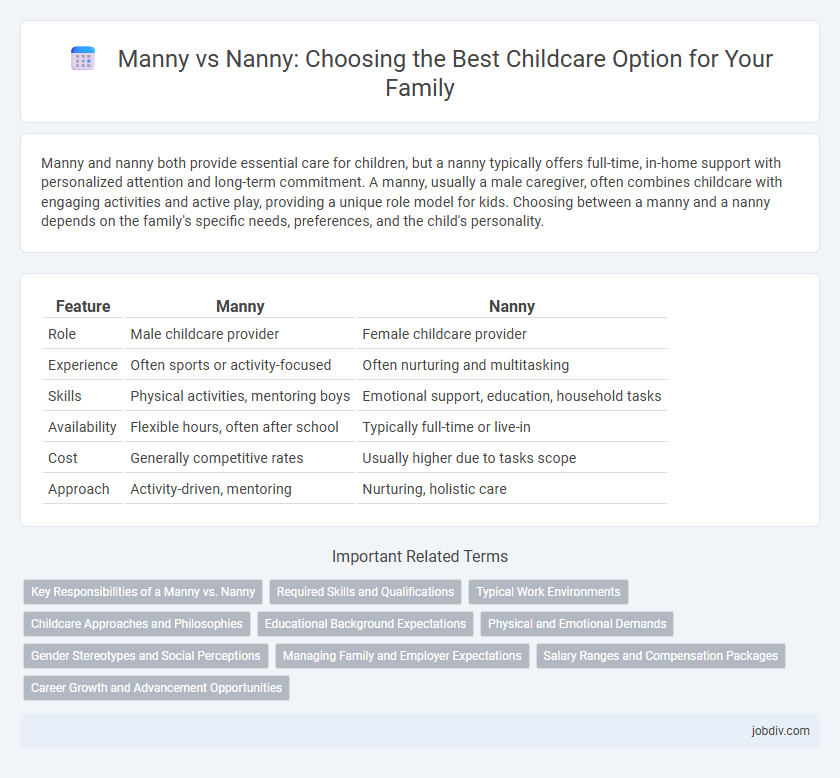Manny and nanny both provide essential care for children, but a nanny typically offers full-time, in-home support with personalized attention and long-term commitment. A manny, usually a male caregiver, often combines childcare with engaging activities and active play, providing a unique role model for kids. Choosing between a manny and a nanny depends on the family's specific needs, preferences, and the child's personality.
Table of Comparison
| Feature | Manny | Nanny |
|---|---|---|
| Role | Male childcare provider | Female childcare provider |
| Experience | Often sports or activity-focused | Often nurturing and multitasking |
| Skills | Physical activities, mentoring boys | Emotional support, education, household tasks |
| Availability | Flexible hours, often after school | Typically full-time or live-in |
| Cost | Generally competitive rates | Usually higher due to tasks scope |
| Approach | Activity-driven, mentoring | Nurturing, holistic care |
Key Responsibilities of a Manny vs. Nanny
A Manny primarily handles tasks like organizing children's schedules, supervising outdoor activities, and assisting with homework, focusing on active engagement and mentorship. A Nanny is responsible for childcare duties such as feeding, bathing, nap times, and ensuring a safe and structured environment inside the home. Both roles require trust and reliability but differ in their emphasis on physical activity and daily routine management.
Required Skills and Qualifications
Manny roles demand strong childcare knowledge, patience, and excellent communication skills to support children's development and household needs. Essential qualifications include CPR and first aid certification, experience in early childhood education, and the ability to manage busy family schedules effectively. Nannies require similar skills but often emphasize nurturing care, multitasking, and providing emotional support alongside educational activities.
Typical Work Environments
Manny typically works in private homes, providing personalized childcare and engaging in family-oriented activities that foster a close bond with children. Nannies often operate within similar domestic settings but may have more formal schedules and handle additional household responsibilities alongside childcare. Both roles demand a safe, nurturing environment but differ in flexibility and scope depending on family needs.
Childcare Approaches and Philosophies
Manny vs Nanny childcare approaches prioritize different philosophies that influence child development and daily routines. Mannys often incorporate structured activities and physical play to support active learning and discipline, whereas nannies typically emphasize nurturing, emotional support, and personalized care in a home-like environment. Understanding these distinct philosophies helps families choose the best fit for their child's individual needs and growth.
Educational Background Expectations
Manny roles often demand a solid educational background, including degrees in child development, education, or psychology, to ensure expertise in age-appropriate learning techniques. Nannies typically meet similar educational expectations but may prioritize certifications like CPR and first aid alongside formal schooling. Both positions require ongoing training to stay updated on child safety standards and early childhood education best practices.
Physical and Emotional Demands
Manny vs Nanny roles differ significantly in physical and emotional demands, with mannys often engaging in more active, outdoor play and physical activities with children. Emotional demands remain high for both, requiring strong empathy, patience, and communication skills to address children's developmental and emotional needs effectively. Balancing these demands impacts job satisfaction and stress levels, making personal resilience crucial for success in either role.
Gender Stereotypes and Social Perceptions
Manny roles challenge traditional gender stereotypes by showing men as nurturing and responsible caregivers, shifting social perceptions about masculinity and parental duties. Studies indicate that children with male caregivers often develop strong emotional intelligence and diverse social skills, breaking the stereotype that caregiving is inherently feminine. Public acceptance of mannies demonstrates evolving attitudes toward gender roles, emphasizing competency over conventional expectations in child-rearing.
Managing Family and Employer Expectations
Manny versus nanny roles require clear communication to manage family and employer expectations effectively, emphasizing tailored childcare approaches and household responsibilities. Defining specific duties, schedules, and behavioral boundaries ensures alignment with family values and daily routines. Consistent feedback and adaptability help maintain trust and a harmonious working relationship between the caregiver and the household.
Salary Ranges and Compensation Packages
Salary ranges for Manny positions typically fall between $600 and $1,200 per week, depending on experience and location, while Nannies often earn between $500 and $1,000 weekly. Compensation packages for Mannys may include benefits such as room and board, health insurance, and bonuses, reflecting their broader responsibilities that can include household management and child discipline. Nanny compensation often emphasizes flexible hours and occasional overtime pay, with some families offering health benefits and paid vacations to attract experienced caregivers.
Career Growth and Advancement Opportunities
Manny roles often provide unique career growth by combining childcare expertise with household management, positioning individuals for advanced opportunities in family concierge services or private household management. Nannies typically focus on childcare, gaining specialized skills in early childhood development and education, which can lead to careers in teaching, childcare administration, or pediatric support. Both professions offer distinct advancement paths influenced by personalized experience, certifications, and professional networking within high-income family environments.
Manny vs Nanny Infographic

 jobdiv.com
jobdiv.com